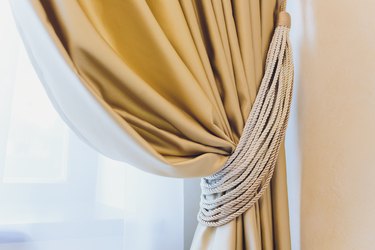
Curtain holdbacks, also known as curtain tiebacks, are both decorative and functional, as they allow you to pull curtains away from the windows and let in more natural light. To fully enjoy both the usefulness and nice looks of curtain tiebacks, you need to be sure to install them properly on the walls.
Doing so usually just means drilling holes and screwing in the hardware, but it's important to measure, mark the ideal placement and use the correct tools to avoid making hard-to-fix mistakes. A wide variety of curtain holdback styles are available, including metal arm-style holdbacks, large knobs, and hooks for hanging fabric or rope wrap-around holdbacks. The mounting method is similar no matter the curtain tieback style you choose.
Video of the Day
Video of the Day
Things You'll Need
Pencil
Level
Tape measure
Stud finder (optional)
Drill with masonry bits
Drywall anchors (optional)
Hammer
Screws
Screwdriver
How to Properly Install Curtain Tiebacks
Step 1
Examine your curtain tiebacks and their hardware and read the manufacturer's installation instructions, if available. Some are simple hooks held to the wall with a couple of screws, while other styles might come in two parts that require assembly in the correct order. Be clear about the way in which your hardware is designed to be attached to the wall.
Step 2
Recruit a friend or family member to help you by holding one of the holdbacks in position with the curtains tucked in place while you examine the effects from different viewpoints in the room.
Tip
As a general rule, holdback hardware should be mounted anywhere from halfway up the window to one-third of the way up from the bottom of the window. A higher position allows for more fullness in the top part of the curtain, and a lower position creates more fullness at the bottom. The hardware should be at least 1 inch out from the side edge of the window, and some styles look best when placed slightly inside the outer edge of the curtain.
Step 3
When you have found the perfect position for the holdback, have the friend hold the hardware in place while you make pencil marks on the wall through the screw holes.
Step 4
If your hardware has two or more screws positioned in a horizontal line, use a level to make sure the dots marking the screws are in a perfectly straight line.
Step 5
With the tape measure, measure the exact vertical distance from the floor or windowsill and exact horizontal distance from the window edge of the screw-hole marks. Transfer those measurements to the other side of the window to mark matching screw holes for the second curtain tieback.
Step 6
Optionally, use a stud finder to determine whether or not there is a wall stud behind your screw-hole marks. If there is not a stud, prepare to install drywall anchors. If there is a stud, you can drill and screw directly into the wall.
Step 7
Install a thin drill bit that is finer than the screw and drill pilot holes through each of the screw-hole marks. Make sure you hold the drill perpendicular to the wall.
Step 8
Install a drill bit that matches the size of the screws and drill into the pilot holes. If you're using them, press drywall anchors into the holes and then carefully hammer in the anchors until they're flush with the wall.
Step 9
Hold the hardware up to the wall so that the screw holes in the hardware align with the anchors or holes. Screw in all of the screws but don't tighten them fully at this time. First, examine the hardware and make sure it's straight. Then, tighten the screws.
Step 10
If your holdbacks have two parts, attach the second part to the wall-mounted part.